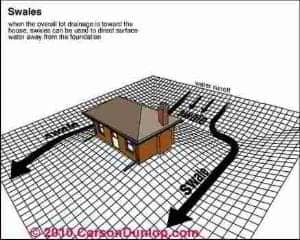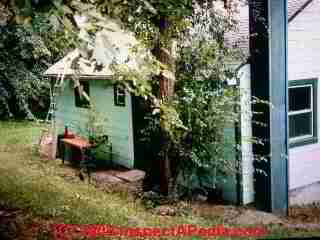to: builder alan toothman construction, inc., woodstock, VA
toothman's engineer
town of strasburg, VA
shenandoah county, VA
jordan bowman, county attorney
mark griffey, county building official
shenandoah county building inspectors
conrad helsley, county board of supervisors
re: foundation drainage for dummies
the material following this paragraph and chart is taken from: Exterior Sources of Foundation Leaks & Basement Water Entry --it's common knowledge for competent builders, competent engineers, competent subcontractors, competent building officials, competent building inspectors and competent homeowners. lack of competency and integrity in the building business and in government inspection and code enforcement have caused expensive problems for homeowners for the past 50 years--as this USDOC chart shows.
By U.S. Department of Commerce, Bureau of Labor Statistics [Public domain], via Wikimedia Commons
*********************************************************************
Common outdoor causes of wet basements or crawl areas. This article describes the common sources of foundation leaks and wet basement and how to find and fix them.
Sources of water outside and around buildings such as roof spillage, surface runoff, groundwater, mishandling of roof gutters and downspouts, and improper exterior foundation drains or footing drains.
Eliminate Exterior Sources of Water that Cause Building Leaks, Water Entry, Flooding
Our sketch of swale drainage construction is provided courtesy of Carson Dunlop Associates.
Before launching a costly repair or retrofit to dry out a wet basement or crawl space it makes sense to check these common sources of basement or crawl space leaks and water entry.
Roof Gutters, Downspouts, & Leaders: the most common source of foundation leaks and wet basements
Before launching a costly repair or retrofit to dry out a wet basement or crawl space it makes sense to check these common sources of basement or crawl space leaks and water entry.
Roof Gutters, Downspouts, & Leaders: the most common source of foundation leaks and wet basements
Roof gutters and downspouts - check to see that roof runoff is effectively disposed of away from the building, and that it is actually working.
- See GUTTERS & DOWNSPOUTS for a guide to types of roof gutter systems.
- See GUTTER DEFECTS LIST and DOWNSPOUT / LEADER DEFECTS for examples of common mistakes in handling roof runoff.
Most of the wet basements that we (DJF) have investigated were suffering from mishandling of roof drainage. Between gutter defects that spill large volumes of water close to the foundation and improper site grading, we estimate that 80 percent or more of basement water entry problems can be explained.
Do not tie the downspouts into the footing drains - you will simply overload the footing drain system and risk future basement water entry. We want to see gutters extended to release roof drainage no less than 10 feet from the home, more is better, and even more important, from the point at which water leaves the downspout end, it should continue to flow away from the building, not back towards it.
Add a splashblock to route surface runoff around a chimney whose side formed a water trap against the foundation wall.
Improper Site Grading, In-Slope Grade May Send Roof Spillage or Surface Runoff into Building Basements or Crawl Areas
Site grading and control of surface runoff - seeGRADING, DRAINAGE & SITE WORK for details.
Keep water away from the foundation.
As we detailed at BASEMENT WATER ENTRY PREVENTION, this means proper site drainage that assures that surface runoff and roof spillage are conducted away from the building.
Our photo (above left) shows a home with an in-slope grade facing the house wall. It would have been relatively easy to install a swale draining hillside water and roof spillage around the left side of the home in this picture.
Instead the owners suffered decades of wet basements until the wet conditions made the home sills so attractive to termites.
Guide to Finish Grading Details to Prevent Foundation Leaks & Water Entry

At grade, the main object is to get water away from the foundation as quickly as possible. Finish grade should slope away from the building for at least 10 to 15 feet, and should not contain low spots that will make water ponds.
Swales: if one or more sides of the building face an upwards sloping hill, slope the finish grade away from the building for at least 10-15 feet, and then shape the finish grade at that point into a swale that itself continues to carry water around to the downhill side of the building.
A swale, illustrated by Carson Dunlop Associates' sketch at left, is a nice word for a "gentle ditch" - it does not have to be deep.
A swale, illustrated by Carson Dunlop Associates' sketch at left, is a nice word for a "gentle ditch" - it does not have to be deep.
Foundation ditches: Do not do what we have found at some flooding basements: an in-slope grade problem that was trapping surface and roof runoff against the house was "fixed" by digging a ditch right against the foundation wall in an attempt to carry water away. The ditch digger simply had built a water trap to guarantee that water would be sent against the foundation wall.
***********************************************************************
It's all pretty simple.
the Virginia Residential Building Code gets it--section R401.3--slope the ground away from foundation walls at -5% minimum (6 inches minimum in 10 feet minimum). https://codes.iccsafe.org/public/document/VRC2012/chapter-4-foundations
the engineer who prepared the approved 2003 grading drainage got it.
How come builder Alan Toothman Construction, Inc. doesn't get it? toothman's engineer? Shenandoah County Virginia Building Inspection and Code Enforcement building official and inspector? Shenandoah County attorney?
It's all pretty simple.
the Virginia Residential Building Code gets it--section R401.3--slope the ground away from foundation walls at -5% minimum (6 inches minimum in 10 feet minimum). https://codes.iccsafe.org/public/document/VRC2012/chapter-4-foundations
the engineer who prepared the approved 2003 grading drainage got it.
How come builder Alan Toothman Construction, Inc. doesn't get it? toothman's engineer? Shenandoah County Virginia Building Inspection and Code Enforcement building official and inspector? Shenandoah County attorney?
virginia
shenandoah county
strasburg
stony pointe
toothman





No comments:
Post a Comment